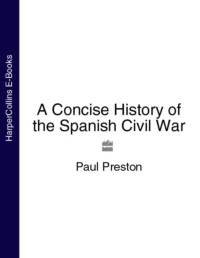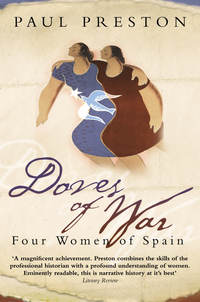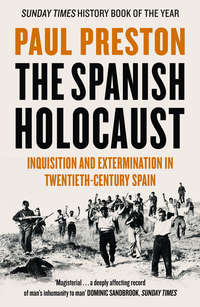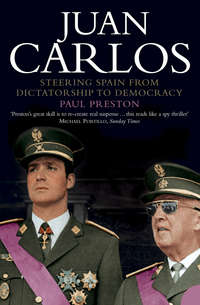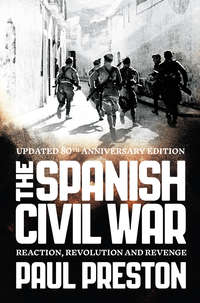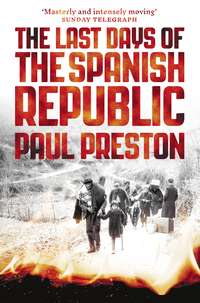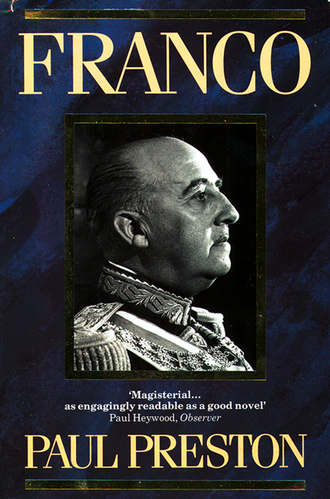
Полная версия
Franco

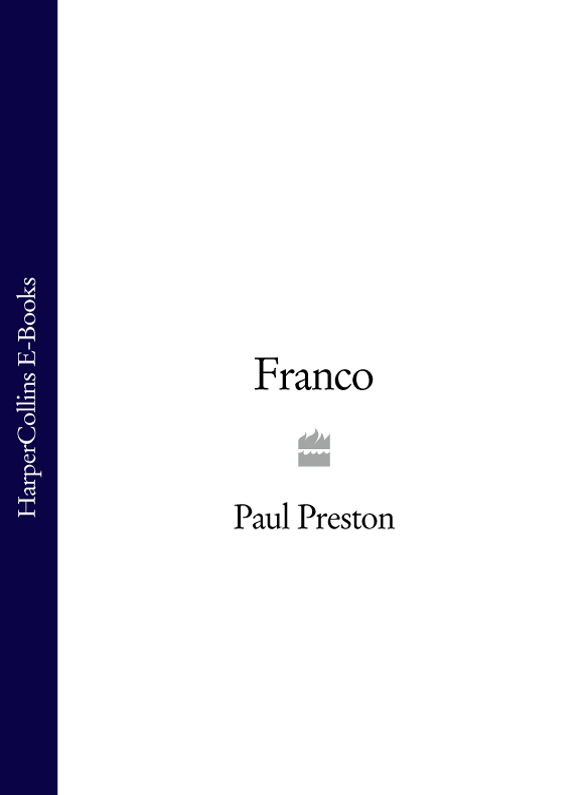
DEDICATION
For James and Christopher
CONTENTS
Cover
Title Page
Dedication
Prologue: The Enigma of General Franco
I The Making of a Hero: 1892–1922 II The Making of a General: 1922–1931 III In the Cold: Franco and the Second Republic, 1931–1933 IV In Command: Franco and the Second Republic, 1934–1936 V The Making of a Conspirator: Franco and the Popular Front, 1936 VI The Making of a Generalísimo: July – August 1936 VII The Making of a Caudillo: August – November 1936 VIII Franco and the Siege of Madrid: October 1936–February 1937 IX The Axis Connection: Guadalajara & Guernica, March – April 1937 X The Making of a Dictator: Franco & the Unificación, April 1937 XI Franco’s War of Annihilation: May 1937–January 1938 XII Total Victory: February 1938–April 1939 XIII Basking in Glory: The Axis Partnership, April – September 1939 XIV The Man Who Would Be Emperor: The Defeat of France, 1940 XV The Price of Empire: Franco and Hitler, September – October 1940 XVI In the Wings: Franco & the Axis November 1940–February 1941 XVII Towards a New Crusade: February 1941–January 1942 XVIII Watching the Tide Turn: January – December 1942 XIX The Hero as Chameleon: January 1943–January 1944 XX ‘Franco’s Victory’: January 1944–May 1945 XXI The Hero Besieged: 1945–1946 XXII A Winning Hand: 1947–1950 XXIII The Sentinel of the West: 1950–1953 XXIV Years of Triumph and Crisis: 1953–1956 XXV Learning to Delegate: Homo Ludens, 1956–1960 XXVI Intimations of Mortality: 1960–1963 XXVII Preparing for Immortality: 1964–1969 XXVIII The Long Goodbye: 1969–1975Epilogue: ‘No enemies other than the enemies of Spain’
Notes
Sources
Index
Acknowledgements
About the Author
Praise
Other Works
Copyright
About the Publisher
PROLOGUE The Enigma of General Franco
DESPITE fifty years of public prominence and a life lived well into the television age, Francisco Franco remains the least known of the great dictators of the twentieth century. That is partly because of the smoke screen created by hagiographers and propagandists. In his lifetime, he was compared with the Archangel Gabriel, Alexander the Great, Julius Caesar, Charlemagne, El Cid, Charles V, Philip II, Napoleon and a host of other real and imaginary heroes.1 After a lunch with Franco, Salvador Dalí said ‘I have reached the conclusion that he is a saint’.2 For others, he was much more. A children’s textbook explained that ‘a Caudillo is a gift that God makes to the nations that deserve it and the nation accepts him as an envoy who has arisen through God’s plan to ensure the nation’s salvation’, in other words, the messiah of the chosen people.3 His closest collaborator and eminence grise, Luis Carrero Blanco, declared in 1957 in the Francoist Cortes: ‘God granted us the immense mercy of an exceptional Caudillo whom we can judge only as one of those gifts which, for some really great purpose, Providence makes to nations every three or four centuries’.4
Such adulation may be dismissed as typical of the propaganda machine of a despotic regime. Nonetheless, there were many who spontaneously accepted these comparisons and many others, who by dint of their relentless repetition, failed to question them. This is not an obstacle to knowing Franco. What does render him more enigmatic is the fact that Franco saw himself in the inflated terms of his own propaganda. His inclination to compare himself to the great warrior heroes and empire-builders of Spain’s past, particularly El Cid, Charles V, Philip II, came to be second nature, and only partly as a consequence of reading his own press or listening to the speeches of his supporters. That Franco revelled in the wild exaggerations of his own propaganda seems at odds with the many eyewitness accounts of a man who was shy in private and inhibited and ill-at-ease on public occasions. Similarly, his cruelly repressive politics may seem to be contradicted by the personal timidity which led many who met him to comment just how little he coincided with their image of a dictator. In fact, the hunger for adulation, the icy cruelty and the tongue-tied shyness were all manifestations of a deep sense of inadequacy.5
The inflated judgements of the Caudillo and his propagandists are at the other extreme from the left-wing view of Franco as a vicious and unintelligent tyrant, who gained power only through the help of Hitler and Mussolini, and survived for forty years through a combination of savage repression, the strategic necessities of the great powers and luck. This view is nearer the truth than the wild panegyrics of the Falangist press, but it explains equally little. Franco may not have been El Cid but was neither so untalented nor so lucky as his enemies suggest.
How did Franco get to be the youngest general in Europe since Napoleon? How did he win the Spanish Civil War? How did he survive the Second World War? Does he deserve credit for the great Spanish economic growth of the 1960s? These are important questions with a crucial bearing on Spanish and European history in the twentieth century and they can be answered only by close observation of the man. He was a brave and outstandingly able soldier between 1912 and 1926, a calculating careerist between 1927 and 1936, a competent war leader between 1936 and 1939 and a brutal and effective dictator who survived a further thirty-six years in power. Even close observation, however, has to grapple with mysteries such as the contrast between the skills and qualities required to achieve his successes and a startling intellectual mediocrity which led him to believe in the most banal ideas.
The difficulties of explanation are compounded by Franco’s own efforts at obfuscation. In maturity, he cultivated an impenetrability which ensured that his intentions were indecipherable. His chaplain for forty years, Father José María Bulart, made the ingenuously contradictory comment that ‘perhaps he was cold as some have said, but he never showed it. In fact, he never showed anything’.6 The key to Franco’s art was an ability to avoid concrete definition. One of the ways in which he did that was by constantly keeping his distance, both politically and physically. Always reserved, at innumerable moments of crisis throughout his years in power, Franco was simply absent, usually uncontactable while hunting in some remote sierra.
The greatest obstacle of all to knowing Franco is that, throughout his life, he regularly rewrote his own life story. In late 1940, when his propagandists would have us believe that he was keeping a lonely and watchful vigil to prevent Hitler pulling Spain into the World War, he found the time and emotional energy to write a novel-cum-filmscript. Raza (Race) was transparently autobiographical. In it, and through its heroic central character, he put right all of the frustrations of his own life.7
Raza was merely the most extreme, and self-indulgent, manifestation of Franco’s tireless efforts to create a perfect past. Like his war diary of 1922, it provides invaluable insight into his psychology. In his scattered writings and thousands of pages of speeches, in his fragments of unfinished memoirs and in innumerable interviews, he endlessly polished his role and remarks in certain incidents, consistently putting himself in the best light and providing the raw material to ensure that any biography would be hagiography. The persistence of many favourable myths is a testimony to his success.
The need to tamper with reality which is revealed by Franco’s tinkering with his own past was indicative of considerable insecurity. He dealt with this not just in his writings but also in his life by creating for himself successive public personae. The security provided by these shields permitted Franco almost always to seem contained and composed. Everyone who came into contact with him remarked on his affably courteous, but always distant, manner. Behind the public display, Franco remained intensely private. He was abundantly imbued with the inscrutable pragmatism or retranca of the gallego peasant. Whether that was because of his origins as a native of Galicia, or the fruit of his Moroccan experiences is impossible to say. Whatever its roots in Franco, retranca may be defined as an evasion of commitment and a taste for the imprecise. It is said that if you meet a gallego on a staircase, it is impossible to deduce if he is going up or down. Franco perhaps embodied that characteristic more than most gallegos. When those close to him tried to get hints about forthcoming ministerial changes, they were rebuffed with skill: ‘People are saying that in the next reshuffle of civil governors so-and-so will go to Province X’, tries the friend; ‘Really?’ replies the sinuous Franco, ‘I’ve heard nothing’. ‘It’s being said that Y and Z are going to be ministers’, ventures his sister. ‘Well’, replies her brother, ‘I haven’t met either of them’.8
The monarchist aviator Juan Antonio Ansaldo wrote of him ‘Franco is a man who says things and unsays them, who draws near and slips away, he vanishes and trickles away; always vague and never clear or categoric’.9 John Whitaker met him during the Civil War: ‘He was effusively flattering, but he did not give a frank answer to any question I put to him. A less straightforward man I never met.’10
Mussolini’s Ambassador Roberto Cantalupo met him some months later and found Franco to be ‘icy, feminine and elusive [sfuggente]’.11 The day after first meeting Franco in 1930, the poet and noted wit José María Pemán was introduced by a friend as ‘the man who speaks best in all Spain’ and remarked ‘I think I’ve just met the man who keeps quiet best in all Spain’ (‘Tengo la sospecha de baber conocido al bombre que mejor se calla en España’).12
In his detailed chronicles of their almost daily contact during more than seventy years of friendship, his devoted cousin and aide-de-camp, Francisco Franco Salgado-Araujo, ‘Pacón’, presents a Franco who issued instructions, recounted his version of events or explained how the world was threatened by freemasonry and Communism. Pacón never saw a Franco open to fruitful dialogue or to creative self-doubt. Another lifelong friend, Admiral Pedro Nieto Antúnez, presented a similar picture. Born, like Franco, in El Ferrol, ‘Pedrolo’ was to be successively ADC to the Caudillo in 1946, Assistant Head of the Casa Civil in 1950, and Minister for the Navy in 1962. He was one of Franco’s constant companions on the frequent and lengthy fishing trips on his yacht, the Azor. When asked what they talked about during the long days together, ‘Pedrolo’ said ‘I have never had a dialogue with the General. I have heard very long monologues from him, but he wasn’t speaking to me but to himself’.13
The Caudillo remains an enigma. Because of the distance that Franco so assiduously built around himself through deliberate obfuscations and silences, we can be sure only of his actions, and, provided they are judiciously evaluated, of the opinions and accounts of those who worked with him. This book is an attempt to observe him more accurately and in more detail than ever before. Unlike many books on Franco, it is not a history of twentieth-century Spain nor an analysis of every aspect of the dictatorship, but rather a close study of the man. Through memoirs and interviews, his collaborators have provided ample material and there are copious despatches by foreign diplomats who dealt with him face-to-face and reported on his activities. Franco’s own writings, his speeches – in which he often held a kind of dialogue with himself – and his recently published papers also constitute a rich, if not easy, source for the biographer. They are the instrument of his own obfuscations but they also provide remarkable insight into his own self-perception.
By use of these sources, it is possible to follow Franco closely as he became successively a conspirator, Generalísimo of the military rebels of 1936 and Caudillo of the victorious Nationalists. Several myths do not survive a comprehensive investigation of his survival of the Second World War and the Cold War and of his devious dealings with Hitler, Mussolini, Churchill, Roosevelt, Truman and Eisenhower. Equally striking is the picture which emerges of his passage from the active dictator of the 1950s to the somnolent figurehead of his last days. By following him step by step and day by day, a more accurate and convincing picture can emerge than has hitherto been current. Indeed, only by such an exhaustive examination can the enigma of the elusive Franco begin to be resolved.
I
THE MAKING OF A HERO
1892–1922
FRANCISCO FRANCO BAHAMONDE was born at 12.30 a.m. on 4 December 1892 in the calle Frutos Saavedra 108, known locally as the calle María, in El Ferrol in the remote north-western region of Galicia. He was christened Francisco Paulino Hermenegildo Teódulo on 17 December in the nearby military parish church of San Francisco.*
At the time, El Ferrol, an inward-looking and still walled town, was a small naval base with a population of twenty thousand. The Franco family had lived there since the early eighteenth century and had a tradition of work in the intendencia naval (pay corps/administration).†1 Franco’s grandfather, Francisco Franco Vietti, was Intendente Ordenador de la Marina (naval paymaster) with a rank equivalent to brigadier general in the Army. He had married Hermenegilda Salgado-Araujo, with whom he had two children. The first, Nicolás Franco Salgado-Araujo, the father of the future Caudillo, was born on 22 November 1855, his sister Hermenegilda on 1 December 1856.
Nicolás followed his father into the administrative branch of the Spanish navy in which, after fifty years service, he rose to be Intendente-General, a rank also equivalent to brigadier general. As a young man, stationed first in Cuba then in the Philippines, Nicolás acquired a reputation for fast living.‡ On 24 May 1890, when he was nearly thirty-five, Nicolás Franco Salgado-Araujo married the twenty-four year-old María del Pilar Bahamonde y Pardo de Andrade in the Church of San Francisco in El Ferrol. She was the pious daughter of Ladislao Bahamonde Ortega, commissar of naval equipment at the port. The union of this free-thinking bon viveur with the conservative, moralistic Pilar was not a success. Nevertheless, they had five children, of whom Nicolás was the first, Francisco the second, followed by Paz, Pilar and Ramón.*2
Franco’s family had been concerned for over a century with the administration of the naval base in El Ferrol. When Franco was born, the town was remote and isolated, separated from La Coruña by a twelve-mile steamer journey to the south across the bay or by forty miles of poor, and in bad weather, often impassable, road. La Coruña was in turn 375 miles, or two days by bone-shaking railway, from Madrid. El Ferrol was hardly a cosmopolitan place. It was a town of rigid social hierarchies in which the privileged caste consisted of naval officers and their families. Naval administrators or merchant navy officers were considered to be of a lower category. Social barriers cut the lower middle-class Franco family off from ‘proper’ naval officers since the administration corps was regarded as inferior to the sea-going Navy, or Cuerpo General. The idea of a heroic family naval tradition, so carefully nurtured by Franco himself in later life, was an aspiration rather than a reality. That can be perceived in Nicolás Franco Salgado-Araujo’s determination that his sons become ‘real’ naval officers.
Partly because a naval commission was a common ambition among the Ferrolano middle class and because of his father’s job, Francisco developed an interest in things of the sea. As a child he played pirates in the harbour with the gangplanks of the ferries and rowed in the tranquil waters of the virtually enclosed ría (firth or fjord) of El Ferrol.3 As an adolescent, he tried to join the Navy. His two primary schools, the Colegio del Sagrado Corazón and the Colegio de la Marina, both specialised in preparing children for the Navy entrance examinations.4 Nicolás Franco Bahamonde did manage to fulfil his father’s expectations, but Francisco’s naval ambitions were to be thwarted. His failure to enter the navy would weigh heavily on him. In Salamanca during the Civil War, it was common knowledge that to please him or deflect his anger it was always worth trying to change the subject to naval matters.5 As Caudillo, he spent as much time as he could aboard his yacht Azor, wore an admiral’s uniform at every opportunity and, when visiting coastal cities, liked to arrive from the sea on board a warship.
His childhood was dominated by the efforts of his mother to cope with the overbearing severity and later the constant absences of his father, the shadow of whose infidelities hung over the home. He was brought up by Doña Pilar in an atmosphere of piety and stifling provincial lower middle class gentility. Marriage had only briefly diminished the number and length of Nicolás Franco Salgado-Araujo’s card games and drinking sessions at the officers’ club. After the birth of his daughter Paz, in 1898, Nicolás had returned to his bachelor habits. The distress that this caused his wife was compounded by the death of Paz in 1903, after an undiagnosed illness lasting four months. Pilar Bahamonde was devastated.6 Nicolás Franco was, at home, a bad-tempered authoritarian who easily lost control of himself if contradicted. His daughter Pilar described him as running the house like a general, although she also claimed that he beat his sons no more than was the norm at the time, a double-edged claim which leaves it difficult to evaluate the scale and intensity of his violence. The young Nicolás bore the brunt of his anger and Ramón also carried a deep resentment of his father and his uncontrolled violence all through his life. Until Nicolás Franco left home in 1907, his children and his wife were often the victims of his frequent rages.
Francisco was too well-behaved, too much of a ‘little old man’ (niño mayor), in his sister’s phrase, to arouse his father’s anger with any frequency. Nevertheless, Pilar recounts the deep sulk that came over him whenever he was cuffed unjustly by his father.7 Unable to win his father’s acceptance and affection, Francisco seems to have turned in on himself. He was a lonely child, withdrawn to the point of icy detachment. A story is told that when he was aged about eight, Pilar heated a long needle until the tip was red-hot and pressed it onto his wrist. Allegedly, gritting his teeth as his flesh burnt, he said only ‘how shocking the way burnt flesh smells’.8 Within the family, Francisco was long overshadowed by his two brothers, Nicolás and Ramón, who were extroverts and took after their father. Nicolás, who became a naval engineer, was the father’s favourite. Interviewed in the press in 1926, Franco père dismissed as unremarkable the achievements of his two younger sons, Francisco as commander of the Foreign Legion and Ramón who had become the first man to fly the south Atlantic.9 Even in later life, when Francisco was Head of State, his father, when asked about ‘his son’, would perversely talk about Nicolás or sometimes Ramón. Only when pressed would Don Nicolás talk about the person he called ‘my other son’.
In total contrast to her despotic husband, Pilar Bahamonde was a gentle, kindly and serene woman. She responded to the humiliations suffered at the hands of the gambling and philandering Nicolás by presenting to the world a facade of quiet dignity and religious piety that hid her shame and the economic difficulties she had to face. That is not to say that the family suffered privations, since she received financial help from her father, Ladislao Bahamonde Ortega, who lived with her after the death of his wife, and also from her husband. Nevertheless, once her husband established residence in Madrid from 1907, what Pilar Bahamonde received from him must necessarily have been limited. There was always a maid in the house, but some sacrifices were required to keep up appearances. Sending all four children to private schools put a strain on the family economy. It has been suggested, although strenuously denied by the family, that she had to take in lodgers.10 Despite these difficulties, her kindness extended to her relations and she helped to bring up the seven younger children of her brother-in-law Hermenegildo Franco.11
Pilar Bahamonde tried to imbue her children with a determination to get on in life and to escape from their situation by study and hard work, a philosophy which seems to have taken root principally with her second son and her daughter Pilar. Nevertheless, all four of her surviving children were to be fearless and powerfully ambitious in one way or another. Nicolás Franco Salgado-Araujo was a liberal, sympathetic to freemasonry and critical of the Catholic Church. In contrast, Pilar Bahamonde was politically conservative and a deeply pious Catholic. Given the circumstances of his childhood, and the nature and ideas of his father, it is hardly surprising that an enduring and unsubtle Catholicism, sexual prurience and a hatred for liberalism and freemasonry should be part of the legacy which the young Franco was left by his mother.12 What is more intriguing is the fact that his brothers followed in the footsteps of Don Nicolás rather than those of Doña Pilar. After her husband left, Doña Pilar always wore black. It seems too that, as Francisco witnessed her introspective piety becoming an effective shield against her misfortunes, he suppressed his own emotional vulnerability at the cost of developing a cold inner emptiness.




